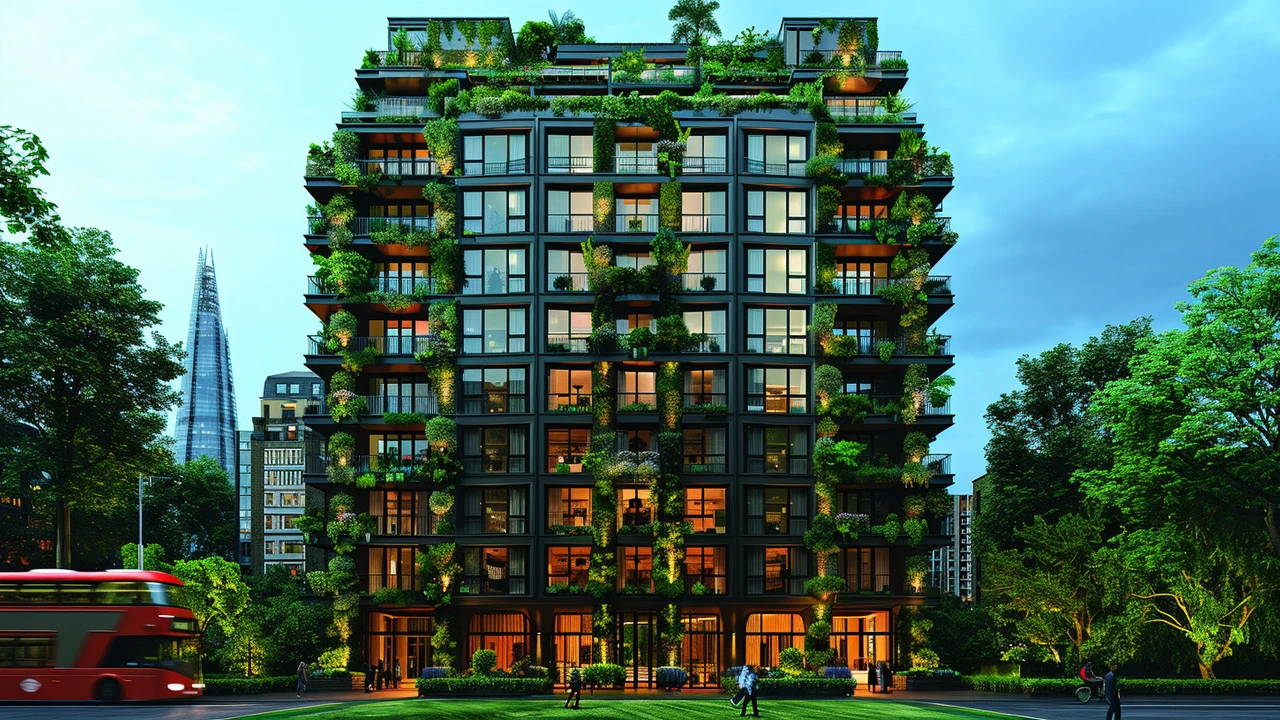Constructivist architecture, originally an avant-garde movement from the early 20th century, has evolved to become a cornerstone in sustainable building design. By focusing on the harmony between structure and environment, it offers innovative solutions for modern ecological challenges.
The beauty of this architectural style lies in its ability to blend form with function while prioritizing eco-friendly materials and energy-efficient systems. This approach not only minimizes environmental impact but also creates spaces that are both aesthetically pleasing and highly functional.
In this article, we will explore how the principles of constructivist architecture can be applied to create sustainable designs, delve into real-life examples, and provide practical tips for incorporating these concepts into contemporary projects.
- Understanding Constructivist Architecture
- Key Principles of Constructivist Design
- Environmental Benefits
- Case Studies
- Tips for Implementing Constructivist Concepts
Understanding Constructivist Architecture
Constructivist architecture emerged from the Russian avant-garde movement in the early 20th century, during a period of profound socio-political changes. This style sought to reflect a new societal order through bold and innovative designs that favored utility, simplicity, and abstract forms over ornamental excess. Architects like Vladimir Tatlin and El Lissitzky were pioneers, pushing the boundaries of what architecture could achieve both aesthetically and functionally.
This architectural style is characterized by its emphasis on geometric shapes, industrial materials, and layouts that prioritize functionality. One can often see extensive use of steel, glass, and concrete. Unlike previous architectural trends, constructivism was not just about creating visually stunning buildings; it was about making structures that served specific purposes, whether it be living spaces, factories, or public areas.
"Constructivist architecture is not merely an aesthetic choice. It stands as a testament to the power of form and function coalescing to serve society." – Michael S. Smith, Architectural Historian
One of the most iconic examples of constructivist architecture is Tatlin’s Tower, officially known as The Monument to the Third International. Though it was never built, it was designed to be a towering steel spiral that symbolized modernity and progress. The design incorporated rotating sections to reflect different governmental functions, embodying the constructivist spirit of combining art and practical use.
The principles of constructivist architecture still resonate today, particularly in the realm of sustainable design. Modern versions of constructivist architecture often integrate sustainable practices, like passive solar heating, rainwater harvesting, and green roofs. These updates ensure that structures are energy-efficient and environmentally friendly while retaining the sharp, innovative aesthetics characteristic of constructivism.
Understanding constructivist architecture involves appreciating both its historical context and its potential for modern application. It's not just an architectural style; it's a philosophy that values the integration of art, technology, and social purpose. By embracing these principles, today's architects can create buildings that are not only visually stunning but also ecologically responsible, contributing to a more sustainable future.

Key Principles of Constructivist Design
At the heart of constructivist architecture are principles that merge innovation with sustainability. This distinctive style emphasizes functionality and efficient use of materials, bringing an element of minimalism that’s both practical and aesthetically compelling. It often incorporates geometric shapes, asymmetry, and the use of industrial materials, providing a futuristic feel while maintaining a harmonious relationship with the environment.
One of the core tenets is the use of local and sustainable materials. This principle ensures that the building process supports the local economy and reduces the carbon footprint associated with transportation. By sourcing materials locally, architects can create designs that are not only sustainable but also deeply connected to their geographical settings.
"Constructivism in architecture is about redefining form and space with a purpose that transcends mere occupation." - Katarina Cak, Architectural Historian
Another essential aspect is adaptability. Constructivist designs often feature modular components, which allow for easy adjustments and expansions. This adaptability extends the lifecycle of buildings, as spaces can be reconfigured to meet changing needs without significant overhauls. By doing so, it promotes a long-term vision of sustainability where buildings evolve with their users.
The integration of natural elements such as light and air circulation is another vital principle. Design strategies like large windows, skylights, and open spaces facilitate natural light and ventilation, reducing the reliance on artificial sources. This not only enhances the energy efficiency of a building but also creates healthier living and working environments.
Constructivist architecture also emphasizes technology and innovation in sustainable design. The inclusion of renewable energy systems like solar panels and rainwater harvesting setups is commonplace. These technologies help buildings operate off-grid to some extent, thus reducing overall energy consumption and promoting environmental stewardship.
In a broader sense, the principles of constructivism encourage a thoughtful and intentional approach to design. It's about more than just building structures; it’s about creating spaces that respect and enhance their surroundings. By incorporating these principles, architects can craft buildings that are not only visually striking but also contribute positively to the environment.
For those looking to implement these concepts, it’s helpful to start with a strong foundation in the basics of sustainable architecture. Consider the local climate, available resources, and the building’s intended use. These factors will guide the choice of materials, design features, and technologies that can be integrated into the project for optimal sustainability.

Environmental Benefits
Constructivist architecture is not just an aesthetic movement; it has profound environmental benefits that make it a vital player in sustainable design. One of its primary contributions is the emphasis on using *eco-friendly materials*. These materials often include recycled steel, reclaimed wood, and natural composites that reduce the carbon footprint of new buildings. By opting for such materials, architects can significantly cut down on the pollution and waste typically associated with construction.
Another crucial aspect is *energy efficiency*. Constructivist buildings are designed with energy-saving mechanisms like solar panels, green roofs, and high-efficiency insulation. This ensures that the structures consume less energy for heating and cooling, leading to lower greenhouse gas emissions. Additionally, incorporating large windows and skylights allows for maximum natural light, reducing the need for artificial lighting during the day.
“Energy efficiency is not just a trend; it is a necessity for the future of our planet,” says Dr. Emily Harrison, an expert in sustainable architecture.
“By integrating smart design with sustainable practices, we can create buildings that are not only beautiful but also reduce our environmental impact significantly.”
Water conservation is another important benefit. Many constructivist designs include systems for rainwater harvesting and greywater recycling. These systems allow buildings to use water more efficiently, reducing the strain on municipal water supplies. For example, collected rainwater can be used for irrigation or flushing toilets, while greywater from sinks and showers can be treated and reused.
It's also worth noting the role of *urban greenery* in these designs. Green roofs and vertical gardens are not just visually appealing; they also contribute to improved air quality and temperature regulation in urban areas. Plants absorb pollutants and help lower temperatures by providing natural cooling through evapotranspiration.
To put these benefits into perspective, here are some statistics:
| Feature | Environmental Impact |
|---|---|
| Green Roofs | Reduce urban heat island effect by 20% |
| Solar Panels | Decrease energy consumption by 30% |
| Reclaimed Materials | Lower carbon footprint by 50% |
These elements showcase how constructivist architecture can lead to significant positive changes in our built environment. By making thoughtful choices and incorporating sustainable practices, architects and builders can reduce the environmental footprint of new constructions and help pave the way for a greener future.

Case Studies
When it comes to constructivist architecture in sustainable design, several landmark projects around the world showcase its efficiency and aesthetic appeal. These examples offer a glimpse into how the principles of constructivist design are transforming the architectural landscape and paving the way for a more sustainable future.
A prime example is the Miles House in Sydney, Australia. This residential project by architect Michael Schwertfeger is a perfect amalgamation of modern constructivist principles with sustainable design. The house uses a dynamic arrangement of geometric shapes and is built with reclaimed materials, ensuring minimal environmental impact. The use of solar panels and a rainwater harvesting system reduces the dependency on non-renewable resources, making it a self-sufficient dwelling.
An international example can be found in the Louvre Abu Dhabi by Jean Nouvel. This museum integrates the sustainability ethos of constructivist architecture through its thoughtfully designed dome, which allows natural light to filter through while reducing the need for artificial lighting. The materials used in its construction are locally sourced, reducing the carbon footprint associated with transportation. This design demonstrates how large-scale buildings can adopt eco-friendly practices without compromising on aesthetics.
In the realm of educational institutions, the California Academy of Sciences in San Francisco stands as a testament to the success of sustainable constructivist design. Renzo Piano’s creation includes a living roof covered with native plants, providing insulation and a habitat for local wildlife. The building’s design encourages natural ventilation, reducing the need for air conditioning. The use of recycled materials further emphasizes its commitment to sustainability.
“We must learn to live within the constraints of our planet. Architecture can lead the way towards a more sustainable future.” — Renzo Piano
Another inspiring example is the Powerhouse Brattørkaia in Trondheim, Norway. This office building claims the title of being the world's northernmost energy-positive building, generating more energy than it consumes. The design incorporates solar panels, a timber structure, and highly efficient insulation, showcasing how constructivist principles can lead to groundbreaking achievements in sustainability.
Lastly, the integration of constructivist architecture into public infrastructure is exemplified by the High Line in New York City. This transformed railway line into an elevated park demonstrates how sustainable design can rejuvenate urban spaces. The project prioritizes native vegetation, sustainable materials, and water management systems, highlighting the environmental benefits of thoughtful design practices.
These case studies illustrate the profound impact of constructivist architecture on sustainable design. By embracing eco-friendly principles and innovative building techniques, these projects not only contribute to the environment but also enrich the aesthetic and functional qualities of the built environment. Each of these examples underscores the potential for architecture to lead the charge in creating a more sustainable future.





